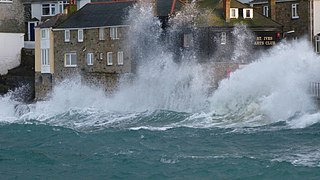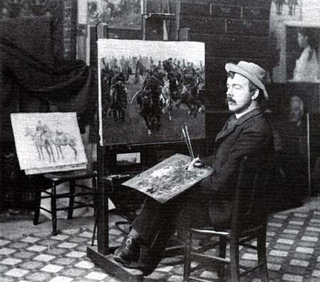Related Research Articles

Hampshire is a ceremonial county in South East England. It is bordered by Berkshire to the north, Surrey and West Sussex to the east, the Isle of Wight across the Solent to the south, Dorset to the west, and Wiltshire to the north-west. The city of Southampton is the largest settlement, and the county town is the city of Winchester.

Winchester is a cathedral city in Hampshire, England. The city lies at the heart of the wider City of Winchester, a local government district, at the western end of the South Downs National Park, on the River Itchen. It is 60 miles (97 km) south-west of London and 14 miles (23 km) from Southampton, its nearest city. At the 2021 census, Winchester had a population of 127,439. The wider City of Winchester district includes towns such as Alresford and Bishop's Waltham. Winchester is the county town of Hampshire and contains the head offices of Hampshire County Council.

John Martin was an English painter, engraver, and illustrator. He was celebrated for his typically vast and dramatic paintings of religious subjects and fantastic compositions, populated with minute figures placed in imposing landscapes. Martin's paintings, and the prints made from them, enjoyed great success with the general public, with Thomas Lawrence referring to him as "the most popular painter of his day". He was also lambasted by John Ruskin and other critics.

Sir Hubert von Herkomer was a Bavarian-born British painter, pioneering film-director, and composer. Though a very successful portrait artist, especially of men, he is mainly remembered for his earlier works that took a realistic approach to the conditions of life of the poor. Hard Times showing the distraught family of a travelling day-labourer at the side of a road, is one of his best-known works.

Winchester School of Art is the art school of the University of Southampton, situated 10 miles (14 km) north of Southampton in the city of Winchester near the south coast of England.

Robert Walter Weir was an American artist and educator and is considered a painter of the Hudson River School. Weir was elected to the National Academy of Design in 1829 and was an instructor at the United States Military Academy. His best-known work is Embarkation of the Pilgrims in the United States Capitol rotunda in Washington, D.C. More than 450 of his works are known, and he created many unsigned paintings that may never be attributed to him.
Bryan Herbert Wynter was one of the St. Ives group of British painters. His work was mainly abstract, drawing upon nature for inspiration.
Mark Earl Dennis is an English former professional footballer who played at left-back for Birmingham City, Southampton, Queens Park Rangers and Crystal Palace. He was capped three times for England under-21s.

Neri di Bicci (1419–1491) was an Italian painter active in his native Florence. A prolific painter of mainly religious themes, he studied under his father, Bicci di Lorenzo, who had in turn studied under his father, Lorenzo di Bicci. The three thus formed a lineage of great painters that began with Neri's grandfather.
Garrick Salisbury Palmer was an English painter, wood engraver, photographer and teacher.

The St Ives School refers to a group of artists living and working in the Cornish town of St Ives. The term is often used to refer to the 20th century groups which sprung up after the First World War around such artists as Borlase Smart, however there was considerable artistic activity there from the late 19th Century onwards.

William Brooke Thomas Trego was an American painter best known for his historical military subjects, in particular scenes of the American Revolution and Civil War.

Edward Thomas Daniell was an English artist known for his etchings and the landscape paintings he made during an expedition to the Middle East, including Lycia, part of modern-day Turkey. He is associated with the Norwich School of painters, a group of artists connected by location and personal and professional relationships, who were mainly inspired by the Norfolk countryside.

David Payne was a Scottish landscape painter.

Paul Lautensack was a German painter and organist.

Petrus Johannes van Regemorter was a Flemish landscape and genre painter, born in Antwerp. He was a pupil of the Academy of that city, but he owed much to his study of the pictures in some private collections. He became a professor in the Academy, and Dean in the Painters' Guild in 1786. Many artists of note studied under him, and he had a large practice as a picture-restorer. In 1814 he was engaged in bringing back the pictures taken by the French to Paris. He died in 1830. In the Antwerp Museum is a Shepherd and Flock by him. He excelled in painting moonlights.

Pierre-Joseph Dedreux-Dorcy was a French genre painter. His surname was Dedreux, but he was usually called Dorcy.
Dennis William Dring was a British portraitist.

Gioacchino Giuseppe Serangeli was a Roman painter, a pupil of Jacques-Louis David, who painted in France during the period of the French Revolution and the subsequent First French Empire. For some time he was one of the more fashionable painters of portraits of the new ruling class in France. His more mature paintings, done after his return to Italy, were also well regarded.
Joseph Powell (1780–1834) was an English watercolour painter and printmaker. He was largely engaged as a teacher of painting in watercolours. He executed landscapes chiefly drawn from English scenery, and was a frequent exhibitor at the Royal Academy exhibitions from 1796 to 1829.
References
- 1 2 "Winchester from the South". Winchester Museums. Archived from the original on 9 January 2019. Retrieved 9 January 2019.
- ↑ Bryan 1889
- ↑ "Obituary". The Gentleman's Magazine. 136: 645. 1824.
- ↑ "Southampton City Art Gallery". BBC Your Paintings. Retrieved 9 January 2019.